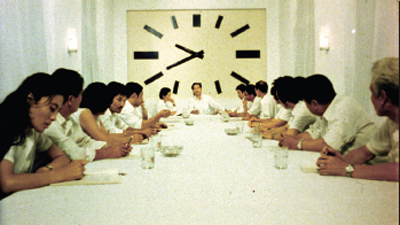Context
The film is often seen as a post-socialist satire on the state of things during the Deng reform era. The ineffectual intellectual (the protagonist) associated with the desire for progress is held back by the remnants of a bureaucracy which cannot go away.
The film can also be seen as a subversion of the spy genre common in the 1950s, which was a reflection of that era's national security fears and paranoia (see essay in Chinese Films in Focus).
The Film
- A kind of postsocialist reworking of the famous literary work ‘Story of Ah Q’, it satirises the regime more deeply than any film reviewers dared admit at the time.
- The sets, especially the all-white symmetric conference room with the absurdly giant clock overlooking everyone, are distinctly modernist rather than realist. This room should typically feel safe and imbued with a benevolent authority linked to the Party, yet this coldness and absurdity makes it feel totally different.
- The affable and honest German engineer Hans Schmidt is seen as perplexed and confused by the backstage intrigues and paranoia of his Chinese hosts --- a subversion of the role of the foreigner, typically the malevolent instigator of an external threat, in the spy film genre during the Maoist period.
- The 360-degrees pan at the end (also circularity of other scenes and objects like the spinning ball-bearing, the chess piece itself and its container substitute).... Huang linked it to the concept of a 'Strange Loop' (Hofstadter), a bit like a Mobius strip. In the end everything is back where it started, because the 'threat', the black cannon, was non-existent.
Reception
Resources:
Essay by Pickowicz on Huang Jianxin's trilogy + essay by Farquhar and Berry in 'Cinematic Landscapes/

No comments:
Post a Comment